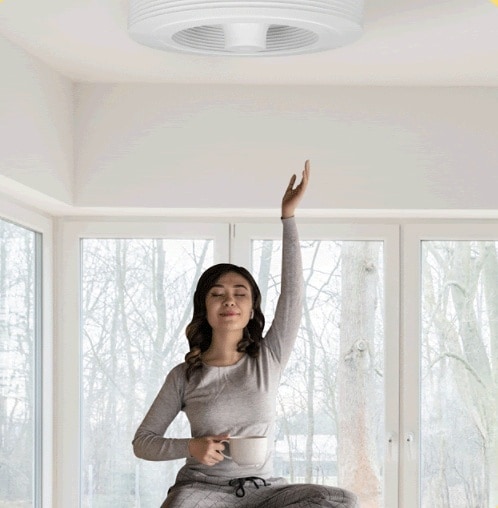In the text of RE2020 concerning ceiling fans [i], it is stated that the fan model used ‘is valid for ceiling heights of less than 3m’.
The Order of 6 April 2022 on the RE2020 specifies two points in Article 4, paragraph VII:
- Ceiling fans that can be taken into account are fans fixed to the building.
- They are installed in such a way as not to present a danger to the occupants.
This means that only ceiling fans are taken into account.
Overseas, ceiling fans have been around for many years, and there is a wealth of feedback.
Secondly, of course, the safety of the occupants must be ensured. Compliance with the international standard NF EN CEI 60335-2-80 (see below) is the benchmark in this respect.
Several regulations describe safety height rules for ceiling fans. For example, in the current application sheet for the DOM RTAA, we can read the following recommendation [ii] :
Minimum height under blades in non-RE2020 regulations
When fans are installed under ceilings, a minimum height under the blades must be defined for safety reasons.
The minimum height between the finished floor and the fan blades is generally one of the recommendations provided by the manufacturer. This is usually set at 2.30 m if there is no protective device.
Guadeloupe’s more recent thermal regulations (published at the end of 2019) are even more explicit [iii]:
Recommendations for the installation of ceiling fans: constraints on ceiling height where there is a ceiling fan or ceiling fan cavity
- We recommend that you comply with the height of the blades specified in standard NF EN CEI 60335-2-80, i.e. a minimum of 2.30 m ;
- The height of the fan (distance between blade and ceiling), which varies according to the model, must also be taken into account when determining the ceiling height;
- If the fan height is not known at the time of construction, it is recommended that a minimum fan height of 0.3 m be used. In this case, a minimum fan height of 0.3 m is recommended, or the occupant should be told which fan models are compatible with the dwelling.
Minimum height under blades: what the standard says
Standard NF EN 60335-2-80 concerns the safety of electric fans for domestic and similar purposes. It falls within the scope of the Low Voltage Directive 73/23/EEC of 19/02/1973 modified by 93/68/EEC of 22/07/199312.
In chapter 7.12.1, standard NF EN CEI 60335-2-80 specifies: ‘The installation instructions must indicate in substance that the fan must be installed in such a way that the blades are more than 2.3 m above the ground’.
The rule to be adopted to ensure user safety is therefore 2.30 m below the blades of ceiling fans.
CE marking and ceiling fans
Ceiling fans sold in the EU are subject to CE marking.
It certifies that the product conforms to current European standards and complies with the applicable essential health, safety and environmental protection requirements.
These essential requirements include the Low Voltage Directive.
The Low Voltage Directive (2014/35/UE) applies to ceiling fans.
The directive explicitly refers to standard EN 60335-2-80, as can be seen on page 54 of the ‘Summary of references of harmonised standards published in the Official Journal – Directive 2014/35/EU‘:
| Legislation reference (A) | ESO (B) | Reference number of the standard (C) | Title of the standard (D) | Date of start of presumption of conformity (1) | OJ reference for publication in OJ (2) |
|---|---|---|---|---|---|
| 2014/35/EU | CEN-CENELEC | EN 60335-2-80:2003, EN 60335-2-80:2003/A1:2004, EN 60335-2-80:2003/A2:2009 |
+6Household and similar electrical appliances – Safety – Part 2-80: Particular requirements for fans | 20/04/2016 | OJ C 249 – 08/07/2016 |
The Low Voltage Directive was transposed into French law by Decree no. 2015-1083 of 27 August 2015, relating to the placing on the market of electrical equipment intended for use within certain voltage limits.
This decree amends the French Consumer Code. It sets out the obligations of manufacturers, importers and distributors regarding the compliance of electrical equipment with European Union safety requirements.
What are the legal consequences of installing ceiling fans with blades less than 2.30 m above the ground?
Standard NF EN 60335-2-80 specifies that: ‘the installation instructions must indicate that the fan must be installed in such a way that the blades are more than 2.30 metres above the ground for fans intended to be mounted at a high level [iv]’.
This standard is the written expression of the rules of the trade and of the minimum safety requirements for professionals.
Players who fail to comply with the instructions for use and the rules of the trade expose themselves to a number of legal risks.
As a result, installers who fail to follow the installation instructions run the risk of being held liable in tort [v], contract[vi], or even criminal law, particularly in the event of an accident. An installer who fails to comply with the installation instructions will not be able to take legal action against the manufacturer in the event of an accident caused by the installation height being too low, and may even lose the benefit of his insurance policy cover.
Secondly, a player who fails to prescribe an installation that complies with the installation instructions could be prosecuted for misleading consumers. Such instructions would lead consumers to believe that fan installations below 2.30 m blade height are safe and reliable, when this is not the case.
[i] Order of 15 August 2021, page 1088
[ii] see page 12
[iii] see page 38
[iv] Fans designed to be mounted at a high level are known as ceiling fans. They differ from floor-mounted fans and wall-mounted fans. In the latter two cases, the units are fitted with safety grilles to prevent them from colliding with the blades.
[v] Article 1240 of the Civil Code
[vi] Articles 1231 et seq. of the Civil Code

With Exhale, the flattest ceiling fan on the market (18 cm), and the Samarat (20 cm), a fan with monobloc blades, you meet the safety standards of 2.30 m under blades, even for ceilings of 2.50 m.


